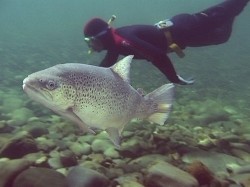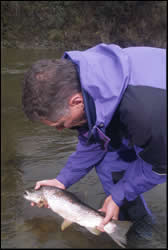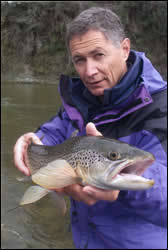Stream health – fish
Research Status: Ongoing |
Brown trout and a drift diver |
Introduction
Particular concerns have been raised over the condition of the Motueka River catchment in the last few years. Annual surveys of brown trout have shown that the observed number of adult trout were about one third of the numbers seen in 1985. The reasons for this decline are unclear but could relate to changes in physical habitat suitability for adult trout in the main river, spawning success in the tributaries, and/or declines in food availability.
Research Approach
Various approaches are used to study fish. Fish surveys using electric fishing techniques, angler census surveys, drift diving, radio-tracking of fish, and habitat quality surveys all provide information about what species are present and the nature of the health of their habitat.
Research Results
The Motueka River catchment contains a range of fish species including native freshwater fish. However it is mostly known for its international brown trout fishery. Trout numbers showed a significant decline in the mid 1980's but have tended to bounce back in recent years. More details»
Fish distribution, as displayed in fish distribution maps, is largely a function of the availability of survey data or reportings rather than the "real" presence or absence.
 |
 |
Radio tagging trout |
Radio tagging trout |
Recent Publications
Recent Presentations
BMPs, BEPs and Guidelines
| Title | Description |
| Marine Recreational Fishing Guidelines | |
| Southland’s Wetlands assessment Guide | A tool kit for use by landowners that includes practical advice and assistance to encourage the main...More » |
| Guide to Marine Farming Consent Conditions for Deemed Coastal Permits |
From guide: This guide aims to support councils in planning for aquaculture1. It provides guid...More » |
| Check, Dlean, Dry: Didymo Factsheet for Whitebaiters |
From website: Whitebaiters need to clean nets and other gear betweeen waterways to help slow t...More » |
| Environmental Best Practice Guidelines for the Offshore Petroleum Industry |
From guide: The Guidelines are voluntary principles to assist Industry to identify, assess and...More » |
Primary Contacts:

|
Rowan Strickland
Email |
Institute Cawthron Institute |
Expertise Coastal and Freshwater Group Manager, Freshwater scientist |

|
Roger Young
Email Phone: (03) 548 2319 Fax: (03) 546 9464 |
Institute Cawthron Institute |
Expertise Land/water interactions, water quality, fisheries, river health |